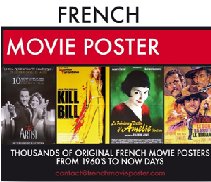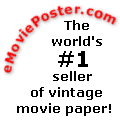PRINTING PROCESSES
The
movie poster first made its appearance at a time when the world
was experiencing the industrialization of special printing processes.
The poster was used extensively in all forms of advertising,
and this was particularly true with the early movie industry.
Over
the years, the movie poster went through many changes, some
of which were the direct result of evolutions in printing processes.
The earliest posters were printed using a process called stone
lithography.
Posters
printed through stone lithography were rich in color and tone.
Heavier card stock posters, just as lobby
cards, inserts and window
cards, were initially printed using a rotogravure
process. In the 1920's, these card stock materials were produced
using the photogelatin or heliotype
process. Less colorful than stone lithographic versions, posters
printed through this process were designed for close viewing
only.
By
the 1930's, color offset printing
was introduced and many of the posters, particularly one
sheets and larger sizes, were printed using this new process.
For
years, studios utilized both the offset printing and lithography
processes simultaneously. The two posters resulting from these
processes can be distinguished by the fact that lithographic
posters show the grain of the litho crayon while, under magnification;
offset posters show the mixing of the dots which are used to
create the colors.





